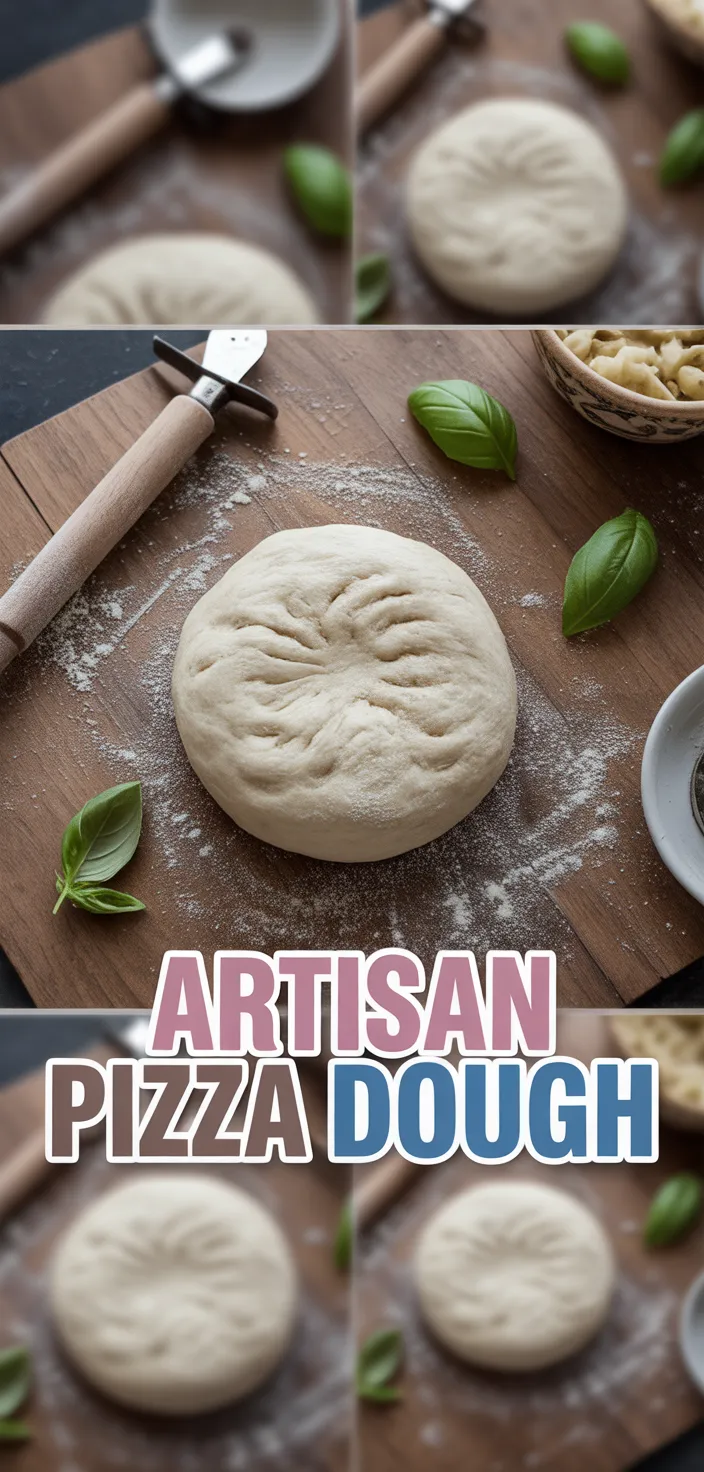I perfected an Artisan Pizza dough using high hydration and long fermentation to deliver billowy soft crust, blistered bubbles and a crackly, chewy texture with a crispy bottom, and I’m sharing the recipe for your next lunch, dinner, or appetizer.

People think pizza is simple, but getting the dough right changes everything. I chased this recipe for months and finally landed on a version that turns into a billowy soft crust with blistered bubbles and a crackly, crispy bottom.
It leans on high hydration and a long slow fermentation so the flavor goes deep, and the texture is chewy but light at the same time. I mostly use bread flour and just enough water, then let time and a little patience do the heavy lifting.
Call it my Best Pizza Dough, it made me stop ordering in, you might not go back either.
Ingredients

- Bread flour: High in protein so it gives pizza structure and chew, not sweet.
- Water: Hydrates dough, affects crust texture and fermentation speed, it’s plain and neutral.
- Instant dry yeast: Tiny living cells that create bubbles, adds mild tang, helps rise.
- Fine sea salt: Brings out flavor, controls yeast activity, adds minerals, not sugary.
- Extra virgin olive oil: Gives richness, softer crumb, adds subtle fruity flavor, healthy fats.
- Semolina or cornmeal: Dusting prevents sticking, adds crunch and slight corn flavor.
- Extra bread flour for handling: Helps shape dough, prevents sticking, can change hydration slightly.
Ingredient Quantities
- 500 g bread flour (about 4 cups, lightly scooped)
- 375 g water (about 1 5/8 cups), room temperature
- 1 g instant dry yeast (about 1/4 teaspoon)
- 10 g fine sea salt (about 2 teaspoons)
- 15 g extra virgin olive oil (about 1 tablespoon optional)
- semolina or fine cornmeal for dusting, a few tablespoons optional
- extra bread flour for handling and shaping, 25 to 50 g optional
How to Make this
1. Weigh everything out so you dont get lost: 500 g bread flour, 375 g room temperature water, 1 g instant yeast, 10 g fine sea salt, 15 g extra virgin olive oil optional, plus a few tablespoons semolina or fine cornmeal for dusting and 25 to 50 g extra flour for handling if needed.
2. In a large bowl stir the water and yeast until mostly dissolved, then add the flour and mix with a spoon or your hand until a shaggy, sticky mass forms and no big dry lumps remain. Dont worry if it feels wet, thats on purpose.
3. Cover and let the dough rest 30 minutes for an autolyse. This helps gluten form with minimal work and makes the dough stronger and easier to handle.
4. Sprinkle the salt over the dough and drizzle the olive oil. Use wet hands to pinch and fold the dough into itself about 6 to 8 times until the salt is distributed and the dough starts to feel a bit smoother. For high hydration dough this folding is better than heavy kneading.
5. Bulk ferment: leave the bowl covered at room temperature for about 2 hours, doing a set of stretch and folds in the bowl every 30 minutes (grab one edge, stretch it up then fold it over). After those first 2 hours transfer to the fridge for a long, cold ferment of 18 to 72 hours for the best flavor and texture. If you need it faster you can ferment 4 to 6 hours at room temp but it wont be as developed.
6. When ready to use, lightly flour your work surface with the extra bread flour if the dough is super sticky, divide the dough into portions for your desired pizza size, and loosely pre shape each into a round. Cover and rest 20 to 30 minutes to relax the gluten.
7. Dust your peel or baking surface with semolina or fine cornmeal so the pizza slides easily. To shape, press from the center out with your fingers leaving a rim, then gently stretch with your knuckles or gravity, keeping as many of the big gas bubbles intact as you can. Dont rework or press out the bubbles.
8. Preheat your oven with a pizza stone or steel on the top rack at the highest temperature it will go for at least 45 to 60 minutes. If you have a broiler or a pizza oven use it. Hot surface equals blistered, crackly crust and a crispy bottom.
9. Top the dough lightly, slide onto the hot stone or steel and bake until the crust is blistered, the top is set and the bottom is crisp, about 7 to 12 minutes depending on your oven. Rotate once if needed for even color.
10. Let the pizza rest 1 to 2 minutes, then slice and finish with a drizzle of extra virgin olive oil if you like. Dont forget to save any extra dough in the fridge for another pizza day.
Equipment Needed
1. Digital kitchen scale for weighing grams accurately
2. Large mixing bowl (big enough for a wet, rising dough)
3. Wooden spoon or sturdy spatula for mixing the shaggy mass
4. Dough scraper or bench scraper to divide and handle sticky dough
5. Plastic wrap or a clean kitchen towel to cover during rests and fridge ferment
6. Small bowl or ramekin for semolina or cornmeal for dusting
7. Pizza peel (preferably rimless) so the pie slides onto the stone easily
8. Pizza stone or steel to preheat on the top rack for a blistered crust
9. Oven that reaches high temps, plus oven mitts for safety
FAQ
Artisan Pizza Dough Recipe Substitutions and Variations
- Bread flour (500 g): use 500 g all purpose flour plus ~20 g vital wheat gluten to get the same chew, or replace up to 150 g with whole wheat for a nuttier loaf but add 10 to 20 g more water.
- Instant dry yeast (1 g): swap with active dry yeast at about 125% by weight (so ~1.25 g) and proof it in a little warm water first, or use fresh (cake) yeast at about 3 g crumbled and dissolved.
- Extra virgin olive oil (15 g): sub with 15 g neutral oil (canola, sunflower) for a cleaner flavor, or 15 g melted butter for richness, or leave it out for a crisper crust.
- Semolina or fine cornmeal for dusting: use fine rice flour, extra bread flour, or a light dusting of polenta; rice flour gives the best nonstick without the gritty bite.
Pro Tips
1) Work the dough with wet hands and resist adding extra flour unless you really need to. A little tackiness helps the crust get those big bubbles. If it’s too sticky to handle, dust the surface not the dough, or rub a tiny bit of flour on your fingers so you dont crush the air pockets.
2) Cold ferment longer when you can. 24 to 72 hours gives way more flavor and better crust texture. If you must rush it, do the shorter room temp option but expect less depth. Also, if your kitchen is cold give it an extra hour at room temp before shaping so it relaxes.
3) Get your stone or steel screaming hot. Preheat on the top rack for at least 45 to 60 minutes. If you dont have either, use an inverted heavy baking sheet and put it high in the oven, and if the bottom is slow to brown, finish a minute under the broiler while watching closely.
4) Keep toppings light and cold. Too much sauce or cheese will weigh the dough down and make the center soggy. Slide the pizza onto the stone using semolina or a bit of cornmeal under the dough, or launch it on a strip of parchment if the peel is sticking.
5) Protect those big bubbles when stretching. Press from the center out, then use gravity and your knuckles to stretch, dont flatten the rim. If a huge bubble forms while baking, poke one tiny hole with a fork or tip the pie to let steam escape so it doesnt blow up and tear.
Artisan Pizza Dough Recipe
My favorite Artisan Pizza Dough Recipe
Equipment Needed:
1. Digital kitchen scale for weighing grams accurately
2. Large mixing bowl (big enough for a wet, rising dough)
3. Wooden spoon or sturdy spatula for mixing the shaggy mass
4. Dough scraper or bench scraper to divide and handle sticky dough
5. Plastic wrap or a clean kitchen towel to cover during rests and fridge ferment
6. Small bowl or ramekin for semolina or cornmeal for dusting
7. Pizza peel (preferably rimless) so the pie slides onto the stone easily
8. Pizza stone or steel to preheat on the top rack for a blistered crust
9. Oven that reaches high temps, plus oven mitts for safety
Ingredients:
- 500 g bread flour (about 4 cups, lightly scooped)
- 375 g water (about 1 5/8 cups), room temperature
- 1 g instant dry yeast (about 1/4 teaspoon)
- 10 g fine sea salt (about 2 teaspoons)
- 15 g extra virgin olive oil (about 1 tablespoon optional)
- semolina or fine cornmeal for dusting, a few tablespoons optional
- extra bread flour for handling and shaping, 25 to 50 g optional
Instructions:
1. Weigh everything out so you dont get lost: 500 g bread flour, 375 g room temperature water, 1 g instant yeast, 10 g fine sea salt, 15 g extra virgin olive oil optional, plus a few tablespoons semolina or fine cornmeal for dusting and 25 to 50 g extra flour for handling if needed.
2. In a large bowl stir the water and yeast until mostly dissolved, then add the flour and mix with a spoon or your hand until a shaggy, sticky mass forms and no big dry lumps remain. Dont worry if it feels wet, thats on purpose.
3. Cover and let the dough rest 30 minutes for an autolyse. This helps gluten form with minimal work and makes the dough stronger and easier to handle.
4. Sprinkle the salt over the dough and drizzle the olive oil. Use wet hands to pinch and fold the dough into itself about 6 to 8 times until the salt is distributed and the dough starts to feel a bit smoother. For high hydration dough this folding is better than heavy kneading.
5. Bulk ferment: leave the bowl covered at room temperature for about 2 hours, doing a set of stretch and folds in the bowl every 30 minutes (grab one edge, stretch it up then fold it over). After those first 2 hours transfer to the fridge for a long, cold ferment of 18 to 72 hours for the best flavor and texture. If you need it faster you can ferment 4 to 6 hours at room temp but it wont be as developed.
6. When ready to use, lightly flour your work surface with the extra bread flour if the dough is super sticky, divide the dough into portions for your desired pizza size, and loosely pre shape each into a round. Cover and rest 20 to 30 minutes to relax the gluten.
7. Dust your peel or baking surface with semolina or fine cornmeal so the pizza slides easily. To shape, press from the center out with your fingers leaving a rim, then gently stretch with your knuckles or gravity, keeping as many of the big gas bubbles intact as you can. Dont rework or press out the bubbles.
8. Preheat your oven with a pizza stone or steel on the top rack at the highest temperature it will go for at least 45 to 60 minutes. If you have a broiler or a pizza oven use it. Hot surface equals blistered, crackly crust and a crispy bottom.
9. Top the dough lightly, slide onto the hot stone or steel and bake until the crust is blistered, the top is set and the bottom is crisp, about 7 to 12 minutes depending on your oven. Rotate once if needed for even color.
10. Let the pizza rest 1 to 2 minutes, then slice and finish with a drizzle of extra virgin olive oil if you like. Dont forget to save any extra dough in the fridge for another pizza day.











